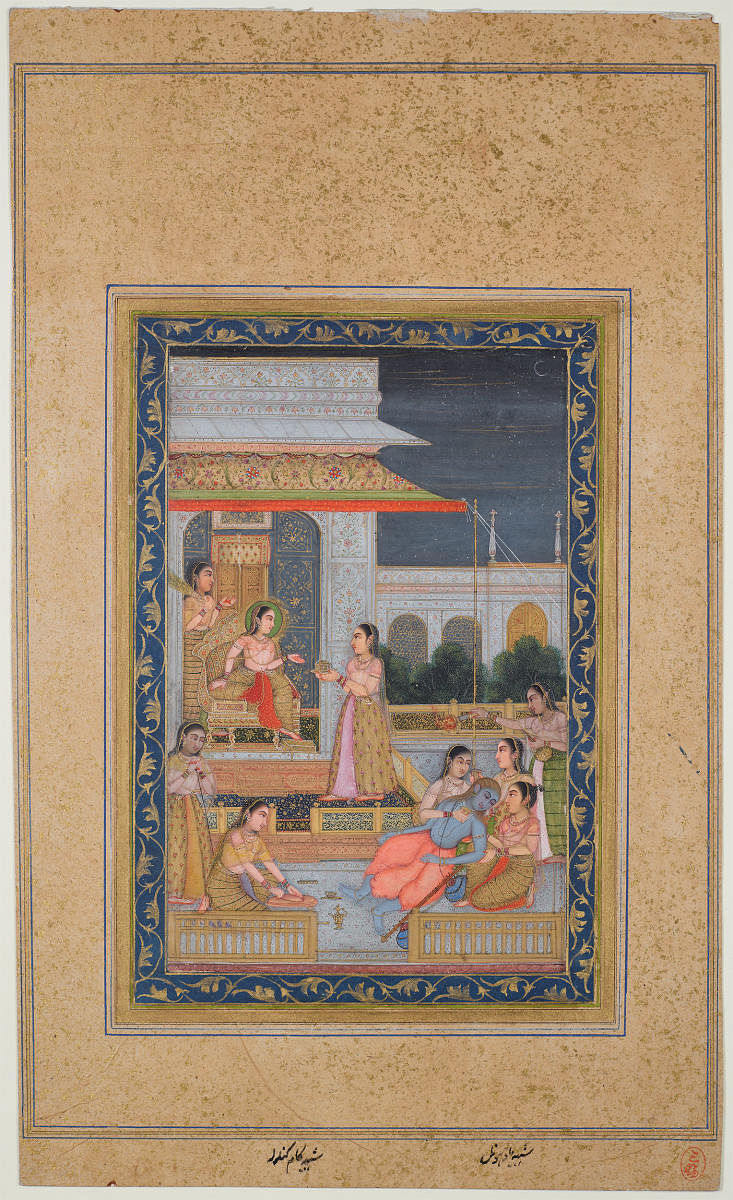
The act of fainting upon the sight of one’s beloved is a common trope in both Sanskrit and Sufi traditions, where swooning becomes the ultimate articulation of a love so divine that it is invisible to the eye, inexpressible, but is the sort that overwhelms the senses. The ancient Indian love story of Madhavanala and Kamakandala is one such text that features the trope of the fainting lover. The folk tale was widely circulated across the Indian subcontinent from the 16th to the 19th centuries through oral retellings, written manuscripts and painted illustrations. Manuscripts of the story have been translated into several languages such as Sanskrit, Braj, Gujarati, Hindi and Urdu, spanning an overwhelming geographical breadth and transcending communal and linguistic boundaries.
The story begins with Madhavanala, an accomplished musician and scholar, who is banished by the king from his home city of Pushpavati since his talent distracted women from their work. Wandering across kingdoms, he arrives in the kingdom of Kamavati, where he sees the courtesan Kamakandala. Enraptured by her beauty and grace, he faints. It is suggested that this moment is symbolic not just of a lover enthralled by the beauty of his beloved but also stands as a metaphor for the dissolving of the self when one is united with the divine.
The moment of Madhavanala fainting upon seeing Kamakandala has been the subject of multiple Rajput and Mughal paintings. Although the scene has been rendered in a variety of visual styles, the paintings share similarities in composition: Kamakandala is always depicted seated on a pavilion, flanked by courtesans and adorned with a halo around her head, idealised as an embodiment of desire. Madhavanala’s beauty, on the other hand, is often depicted with iconography associated with Krishna — with blue skin and playing the veena. A crowd of courtesans surrounding the couple are shown engaged in a flurry of movement, serving Kamakandala and attempting to revive the unconscious Madhavanala. As if oblivious to the chaos, the couple is united in a quiet stillness, suggesting that the ideal response to love is internal and transcendent.
Interestingly, it is the very absence of touch and their non-meeting gazes that capture the couple’s love. In several variations of this scene, created in different royal ateliers, the lovers are separated by a physical distance: Madhavanala faces away from his beloved, his eyes either half-closed or averted downwards while Kamakandala looks towards a courtesan, seemingly unperturbed by Madhavanala’s plight.
The distance between the lover and the beloved is not just a physical separation but rather, a psychological one — between the conscious and the subconscious, between the bodily and the disembodied, between sight and blindness. In Sufi and Sanskrit conceptions, love is intricately tied to visual perception — the idealised image of one’s beloved, conjured in one’s imagination, evokes a response that is as powerful as their actual presence. What appears to be apathy between the lovers is therefore seen as a sublime, hidden love that exceeds ordinary attachment.
‘Discover Indian Art’ is a new fortnightly column that delves into fascinating stories on art from across the sub-continent, curated by the editors of the MAP Academy Encyclopaedia of Art. Find them on Instagram as @map_academy